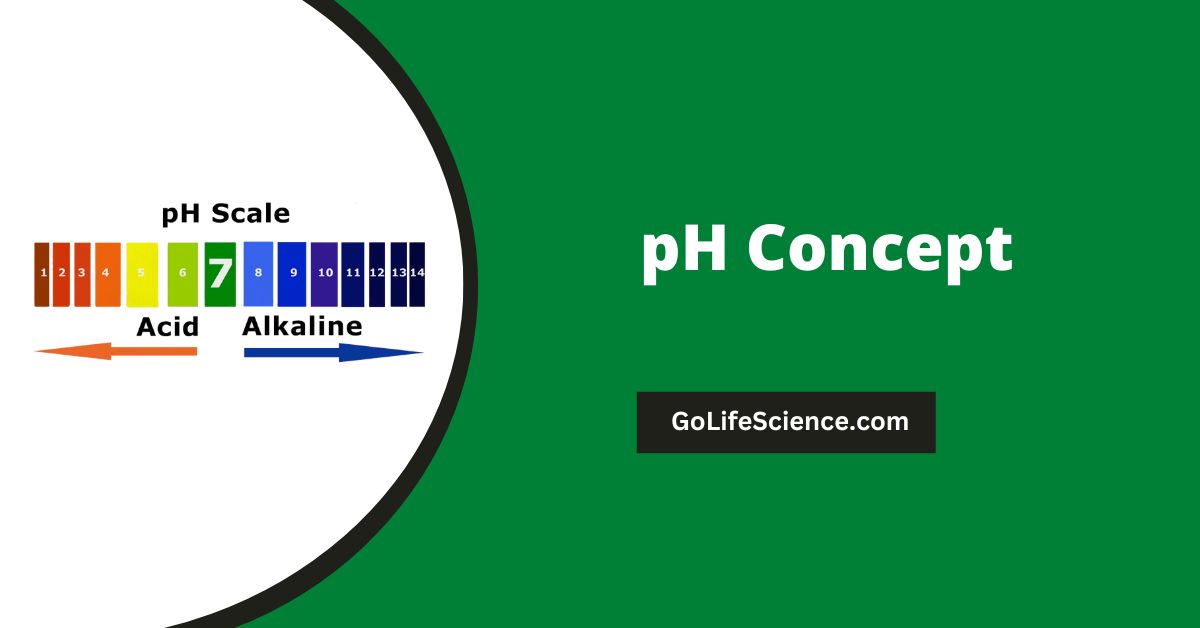
The pH concept is fundamental in chemistry, biology, environmental science, and various industrial applications. It plays a crucial role in determining the acidity or alkalinity of a substance. Whether it’s human health, agriculture, food processing, or industrial processes, understanding pH is essential for maintaining balance and efficiency.
In this article, we will explore the pH concept in-depth, covering its definition, scale, importance, applications, and methods of measurement. Additionally, we will discuss how pH affects different fields, from water quality to human health.
Table of Contents
What is pH?
The term pH stands for “potential of hydrogen.” It also means “power of hydrogen.” It shows the concentration of hydrogen ions (H⁺) in a solution. It is a logarithmic scale that measures how acidic or basic a substance is, ranging from 0 to 14.
- Acidic solutions (pH < 7) contain a higher concentration of hydrogen ions.
- Neutral solutions (pH = 7) have an equal balance of hydrogen and hydroxide ions.
- Basic or alkaline solutions (pH > 7) contain more hydroxide ions (OH⁻) than hydrogen ions.
The pH Scale: A Closer Look
The pH scale is logarithmic, meaning that each unit change shows a tenfold difference in hydrogen ion concentration.
| pH Value | Nature | Example |
|---|---|---|
| 0 – 3 | Strong Acid | Battery Acid, Stomach Acid |
| 4 – 6 | Weak Acid | Orange Juice, Vinegar |
| 7 | Neutral | Pure Water |
| 8 – 10 | Weak Base | Baking Soda, Seawater |
| 11 – 14 | Strong Base | Bleach, Ammonia |
Discovery of the pH Scale by Sørensen

In 1909, Danish chemist Søren Peter Lauritz Sørensen (9 January 1868 – 12 February 1939) introduced a logarithmic scale. He used it to express the hydrogen ion concentration (H⁺) in solutions. This scale was termed “pH,” where:
- “p” stands for “power” (from the German term potenz or the French puissance).
- “H” represents hydrogen ion concentration.
This concept revolutionized chemistry, biology, and industrial applications, providing a standardized method for measuring acidity and alkalinity in solutions.
Understanding the pH Concept
Sørensen defined the pH of a solution as:
pH=−log[H+]
This means that pH is the negative logarithm (base 10). It represents the hydrogen ion concentration, which is measured in moles per liter (M). The “p” in pH specifically denotes “negative logarithm”.
Calculating pH: A Practical Example
For a neutral solution at 25°C, the concentration of hydrogen ions [H+] is:
[H+]=1.0×10−7 M
Applying Sørensen’s formula:
pH=−log(1.0×10−7)
Using logarithmic properties:
pH=−(log1.0+log10−7)
Since log1.0=0 and log10−7=−7.0, we get:
pH=−(0+(−7.0))=7.0
So, at 25°C, the pH of a neutral solution is exactly 7.0. This number is not random. It is the ion product of water (Kw). This provides a round number at this temperature.
This scientific approach to quantifying acidity and alkalinity is crucial in chemistry, medicine, agriculture, and water treatment. It plays a role in countless other fields.
Importance of pH in Various Fields
- pH in Chemistry: In chemistry, pH is a critical parameter for acid-base reactions and buffer solutions. Many chemical reactions depend on pH levels to function correctly, especially in industrial manufacturing processes.
- pH in Biology and Human Health: The human body maintains a pH balance for optimal functioning:
- Blood pH: Ranges between 7.35 and 7.45. Any imbalance can lead to severe health issues like acidosis (low pH) or alkalosis (high pH).
- Stomach pH: Highly acidic (1.5 to 3.5) to aid digestion.
- Skin pH: Slightly acidic (~5.5) to protect against harmful bacteria.
- Urine pH: Varies based on diet and health conditions.
- pH in Agriculture and Soil Health: Soil pH affects plant growth, nutrient availability, and microbial activity.
- Acidic Soil (pH < 6.5): May cause nutrient deficiencies and poor plant health.
- Neutral Soil (pH ~7): Ideal for most crops.
- Alkaline Soil (pH > 7.5): Can lead to reduced nutrient absorption and poor crop yield.
- Farmers adjust soil pH using lime (to raise pH) or sulfur (to lower pH) for better crop production.
- pH in Water Quality and Environmental Science: Water pH is a key indicator of pollution and aquatic life sustainability.
- Natural rainwater pH: ~5.6 due to dissolved CO₂.
- Acid Rain: Below 5.0 due to industrial emissions.
- Drinking Water: Should be between 6.5 and 8.5 for safety.
- High or low pH levels in water can harm fish, plants, and ecosystems.
- pH in Food Industry: pH plays a crucial role in food preservation, fermentation, and taste.
- Acidic Foods (pH < 4.6): Pickles, yogurt, and citrus fruits resist bacterial growth.
- Neutral to Slightly Basic Foods: Milk, bread, and fresh vegetables.
- Food manufacturers control pH using additives like citric acid and sodium bicarbonate to improve shelf life and quality.
- pH in Industrial Applications:
- Cosmetics: Maintaining a balanced pH ensures skin-friendly formulations.
- Pharmaceuticals: pH impacts drug stability and absorption.
- Textile & Paper Industry: Proper pH control enhances quality and durability.
- Swimming Pools: Maintaining pH between 7.2 to 7.8 prevents algae growth and skin irritation.
How to Measure pH?
Measuring pH is crucial in various industries, scientific research, and daily life to ensure safety, quality, and proper functionality. Several methods exist to determine pH levels, ranging from simple paper-based tests to advanced digital meters. Below, we explore the most common techniques used to measure pH accurately.
1. pH Paper (Litmus Paper)
One of the simplest and most affordable ways to test pH is by using litmus paper or universal pH paper. These papers are treated with special dyes that change color based on the acidity or alkalinity of a solution.
How it Works:
- A strip of pH paper is dipped into a solution.
- The paper changes color depending on the pH level.
- The resulting color is compared to a reference chart to estimate the pH value.
Advantages:
- Quick and easy to use: Provides instant results.
- Cost-effective: Available at low prices.
- Portable: Can be carried anywhere, making it ideal for field testing.
Disadvantages:
- Limited accuracy: Provides only an approximate pH value.
- Single-use: Cannot be reused.
- Subject to interpretation: Color changes may be difficult to match accurately to a pH chart.
Applications:
- Educational purposes: Used in school experiments.
- Household testing: Checking the acidity or alkalinity of common liquids.
- Basic water quality assessments: Monitoring pH in aquariums and swimming pools.
2. pH Indicators (Liquid Indicators)
pH indicators are chemical compounds that change color at specific pH levels. They are commonly used in laboratory experiments where precise pH control is necessary.
How it Works:
- A few drops of a pH indicator solution are added to a liquid sample.
- The solution changes color depending on the pH of the sample.
- The color is matched against a pH chart to determine the approximate pH value.
Common pH Indicators and Their Color Changes: Advantages:
| Indicator | pH Range | Color Change |
| Litmus | 4.5 – 8.3 | Red in acid, Blue in base |
| Methyl Orange | 3.1 – 4.4 | Red in acid, Yellow in base |
| Bromothymol Blue | 6.0 – 7.6 | Yellow in acid, Blue in base |
| Phenolphthalein | 8.2 – 10.0 | Colorless in acid, Pink in base |
- Simple to use – Requires only a few drops.
- Widely available – Used in laboratories and educational settings.
- Good for titrations – Helps determine end points in acid-base reactions.
Disadvantages:
- Not highly precise: Only provides an estimated pH range.
- May not work in dark or colored solutions: Hard to see color changes in some samples.
Applications:
- Scientific research: Used in acid-base titrations.
- Soil pH testing: It helps determine soil acidity or alkalinity.
- Water quality testing: Used to check pH levels in natural water bodies.
3. pH Meter (Electrode Method)
A pH meter is an electronic device that provides highly accurate pH measurements. It consists of a glass electrode that detects hydrogen ion activity in a solution. It also has a digital display that shows the pH value.
How it Works:
- The glass electrode is placed in the solution.
- The electrode detects the electrical potential (voltage) generated by hydrogen ion concentration.
- The pH value is displayed digitally on the meter.
Types of pH Meters:
- Portable pH Meters – Small, battery-powered devices used in field applications.
- Benchtop pH Meters – Larger, more precise devices used in laboratories.
- Industrial pH Sensors – Integrated into water treatment plants, chemical industries, and food production facilities.
Advantages:
- Highly accurate – Provides precise pH readings up to two decimal places.
- Reusable – Can be used multiple times with proper maintenance.
- Reliable for research and industry – Essential for scientific and industrial applications.
Disadvantages:
- Requires calibration – Needs regular calibration using buffer solutions (pH 4, pH 7, pH 10) for accurate readings.
- Expensive – Costs more than pH paper or indicators.
- Sensitive to contamination – Must be cleaned after each use to maintain accuracy.
Applications:
- Laboratory experiments – Used in scientific research and academic studies.
- Water treatment plants – Ensures safe drinking water.
- Food industry – Controls pH in dairy, brewing, and fermentation processes.
- Pharmaceuticals – Ensures drug stability and effectiveness.
4. pH Test Strips
pH test strips are an improved version of litmus paper, containing multiple color indicators for more precise pH measurement. They are commonly used in medical, cosmetic, and industrial applications.
How it Works:
- A test strip is dipped into a liquid sample.
- The strip changes color based on the solution’s pH.
- The color pattern is compared to a detailed pH scale chart to determine the exact pH value.
Advantages:
- More precise than litmus paper – Offers a broader range of pH values.
- Convenient and disposable – Ideal for on-the-go testing.
- Affordable – Less expensive than digital meters.
Disadvantages:
- Less accurate than a pH meter – Cannot provide decimal precision.
- One-time use – Not reusable.
- Can be affected by moisture – Must be stored in a dry place.
Applications:
- Medical testing – Urine and saliva pH monitoring.
- Cosmetic industry – Skincare product testing.
- Home water testing – Used for pools, aquariums, and drinking water.
Choosing the Right pH Measurement Method
Selecting the appropriate pH measurement method depends on accuracy requirements, cost, and application.
| Method | Best For | Accuracy | Cost | Ease of Use |
| pH Paper | General testing (household, school) | Low | Low | Very Easy |
| pH Indicators | Lab experiments, titrations | Medium | Low | Easy |
| pH Meter | Industrial, research, food processing | High | High | Moderate |
| pH Test Strips | Medical, cosmetic, water testing | Medium | Medium | Very Easy |
For general use, pH paper and test strips are sufficient. However, for scientific, industrial, and precise applications, a pH meter is the best option.
Measuring pH is essential in many fields, including chemistry, medicine, agriculture, food processing, and water quality management. The choice of method depends on the level of accuracy required and the nature of the substance being tested. Proper pH measurement ensures health, safety, and efficiency. This applies in numerous industries and daily applications, whether using litmus paper, liquid indicators, test strips, or digital pH meters.
How to Maintain pH Balance?
pH plays a vital role in maintaining equilibrium in natural ecosystems, human health, and industrial processes. Any deviation from the optimal pH range can lead to serious environmental, health, and economic consequences. Below, we explore the extensive impacts of pH imbalance in various domains.
1. Effects of pH Imbalance in the Environment
Environmental pH changes can result from natural processes. These include volcanic activity and soil composition. They can also arise from human activities, such as industrial emissions and deforestation. Even slight pH variations can disrupt ecosystems, affect biodiversity, and cause long-term environmental damage.
a) Acid Rain and Its Consequences
Acid rain occurs when sulfur dioxide (SO₂) from factories mixes with water in the air. Nitrogen oxides (NOₓ) also mix with water in the air. This combination forms sulfuric and nitric acids.
Effects of Acid Rain:
- Soil Degradation: Acid rain lowers soil pH, making essential nutrients like calcium, magnesium, and potassium less available for plant growth.
- Crop Damage: High soil acidity disrupts root function, stunts plant growth, and reduces agricultural productivity.
- Water Contamination: Acid rain lowers the pH of lakes and rivers, harming fish and aquatic organisms.
- Structural Damage: Acidic precipitation corrodes buildings, bridges, and monuments, especially those made of limestone and marble.
b) Ocean Acidification and Marine Life Decline
Excess carbon dioxide (CO₂) from human activities dissolves in seawater, forming carbonic acid, which lowers the ocean’s pH. This phenomenon, known as ocean acidification, has devastating effects on marine ecosystems.
Effects of Ocean Acidification:
- Decline in Coral Reefs: Acidic waters dissolve calcium carbonate, weakening coral structures and leading to coral bleaching.
- Harm to Shellfish: Acidification prevents shellfish like oysters, clams, and mussels from forming strong shells, reducing their survival rates.
- Disruption of Marine Food Chains: Many marine species depend on plankton and shellfish; their decline affects the entire ecosystem.
- Changes in Fish Behavior: Some studies indicate that acidic waters can impair fish senses, making them more vulnerable to predators.
c) Soil pH Imbalance and Agricultural Impact
Soil pH affects nutrient availability, microbial activity, and plant growth. A shift in soil pH—either too acidic or too alkaline—can lead to severe consequences for agriculture.
Effects of Soil Acidity (pH < 6.0):
- Reduces the availability of phosphorus, calcium, and magnesium.
- Increases aluminum and manganese toxicity, which can damage plant roots.
- Reduces beneficial microbial activity, affecting nitrogen fixation and decomposition.
Effects of Soil Alkalinity (pH > 7.5):
- Limits the availability of essential nutrients like iron, zinc, and phosphorus.
- Promotes soil compaction, making it harder for plant roots to penetrate.
- Encourages salt buildup in arid regions, harming crops and soil structure.
2. Effects of pH Imbalance on Human Health
The human body requires a stable pH balance for optimal physiological functions. The pH of blood, stomach acid, and other bodily fluids is tightly regulated to prevent health disorders.
a) Acidosis (Low Blood pH) and Its Effects
Acidosis occurs when blood pH drops below 7.35, indicating an excess of hydrogen ions (H⁺). It can result from medical conditions, metabolic imbalances, or excessive acid intake.
Types of Acidosis:
- Respiratory Acidosis: Caused by impaired lung function leading to CO₂ buildup (e.g., chronic obstructive pulmonary disease—COPD).
- Metabolic Acidosis: Caused by excessive acid production due to diabetes (ketoacidosis), kidney failure, or prolonged diarrhea.
Symptoms of Acidosis:
- Fatigue and Weakness: Lack of oxygen transport due to low pH.
- Confusion and Dizziness: Affects brain function and nervous system responses.
- Shortness of Breath: Lungs try to compensate by increasing respiration.
- Bone and Muscle Loss: Chronic acidosis leads to calcium depletion from bones, increasing the risk of osteoporosis.
b) Alkalosis (High Blood pH) and Its Effects
Alkalosis occurs when blood pH rises above 7.45, usually due to excessive loss of hydrogen ions or high bicarbonate levels.
Types of Alkalosis:
- Respiratory Alkalosis: Caused by excessive breathing (hyperventilation), leading to CO₂ loss.
- Metabolic Alkalosis: Occurs due to vomiting, excessive antacid consumption, or kidney dysfunction.
Symptoms of Alkalosis:
- Muscle Twitching and Cramping: Caused by disturbed calcium and potassium levels.
- Nausea and Vomiting: Stomach irritation from alkaline imbalance.
- Nervous System Disturbances: Tingling sensations, lightheadedness, and tremors.
- Heart Irregularities: Abnormal heart rhythms due to electrolyte imbalances.
c) Stomach pH and Digestive Issues
The stomach maintains a highly acidic pH (1.5 – 3.5) to break down food and kill harmful bacteria. A disrupted stomach pH can lead to digestive disorders.
Effects of Low Stomach Acid (Hypochlorhydria):
- Poor digestion and nutrient malabsorption (especially vitamin B12, iron, and calcium).
- Increased risk of bacterial infections due to insufficient acid to kill pathogens.
- Acid reflux and gastroesophageal reflux disease (GERD) due to improper digestion.
Effects of High Stomach Acid (Hyperacidity):
- Gastritis and Ulcers: Excess acid damages the stomach lining.
- Heartburn and Acid Reflux: Causes discomfort and potential esophageal damage.
- Increased Risk of Kidney Stones: Acidic urine promotes stone formation.
3. Effects of pH Imbalance in Industries
Industries rely on strict pH control to ensure product quality, efficiency, and safety. Unregulated pH levels can result in economic losses, equipment damage, and health hazards.
a) Corrosion and Equipment Damage
Many industries use water in cooling systems, boilers, and chemical reactions. If the water’s pH is too high or low, it can corrode metal surfaces and damage machinery.
Consequences of Industrial Corrosion:
- Increased maintenance costs due to equipment failure.
- Reduced efficiency in chemical processing and manufacturing.
- Contamination of industrial fluids and loss of product quality.
b) Pharmaceutical and Cosmetic Product Instability
The pH of medicines, cosmetics, and skincare products determines their effectiveness and safety.
Effects of pH Imbalance in Pharmaceuticals:
- Affects drug solubility, altering its absorption in the body.
- Reduces the shelf life of medicines due to chemical degradation.
Effects of pH Imbalance in Cosmetics:
- High pH can cause skin irritation and dryness.
- Low pH may lead to microbial contamination, causing infections.
c) Food and Beverage Industry Issues
pH balance is essential in food production to maintain taste, texture, and preservation.
Effects of pH Imbalance in Food:
- Spoilage: Improper pH allows harmful bacteria and mold to grow.
- Fermentation Failure: Many fermented products (yogurt, beer, cheese) require specific pH conditions.
- Texture Changes: pH affects protein structure in food, altering firmness and consistency.
Biological Significance of pH and Its Role in Biochemical Processes
pH plays a crucial role in biological systems. It influences the structure, function, and stability of biomolecules such as DNA, proteins, enzymes, and cellular membranes. A small change in pH can have big effects on biochemistry and physiology. It can alter important processes like gene expression, protein folding, enzyme activity, and metabolic reactions.
A. Tautomeric Forms of Purines and Pyrimidines
Tautomerization is a dynamic isomerization process. A proton moves within a molecule, and covalent bonds are rearranged simultaneously. This effect is very important in nucleic acid chemistry. It changes how purines (adenine and guanine) and pyrimidines (cytosine, thymine, and uracil) pair with bases.
pH and DNA/RNA Stability
- There are different tautomeric forms of purine and pyrimidine bases, but when they reach the physiological pH (about 7.4), they change into their specific tautomeric forms.
- These particular tautomers are necessary for hydrogen bonding between base pairs that are complementary. This makes sure that DNA double helices and RNA strands form correctly and stay stable.
- Any change in pH that happens in tautomeric forms can mess up the normal pairing of bases. This disruption could cause mutations. It may lead to mistakes in DNA replication and poor gene expression.
Thus, pH homeostasis is essential for maintaining the natural three-dimensional structure of nucleic acids and ensuring genetic stability.
B. Isoelectric pH and Molecular Ionization
pH plays a fundamental role in the ionization of biomolecules, particularly those with ionizable polar groups such as:
- Amino acids
- Proteins
- Nucleic acids
- Phospholipids
- Mucopolysaccharides
Each molecule has a specific isoelectric pH (pI). This is the pH at which it exists as a zwitterion. It carries both positive (cationic) and negative (anionic) charges. However, it has a net charge of zero.
Biological Importance of Isoelectric pH
- At the isoelectric point (pI), molecules exhibit minimum electrostatic repulsion, allowing them to aggregate and precipitate easily.
- Zwitterions do not migrate in an electric field, which is crucial for techniques like protein purification and separation.
This concept is widely applied in biochemistry for protein characterization, separation, and crystallization techniques.
C. pH in the Isolation and Separation of Proteins and Amino Acids
The charge state of proteins and amino acids is highly dependent on pH. Thus, pH regulation is essential for their isolation and purification from biological samples. Several advanced biochemical techniques leverage this principle:
Techniques Utilizing pH for Protein and Amino Acid Separation
- Ion-Exchange Chromatography: Uses a charged stationary phase to separate proteins based on their net charge, which varies with pH.
- Paper Electrophoresis: It separates biomolecules based on their movement in an electric field. This movement depends on their charge at a given pH.
- Isoelectrophoresis: The process separates proteins by applying an electric field across a pH gradient. This causes proteins to migrate until they reach their isoelectric point (pI).
Scientists can selectively precipitate, purify, and isolate biomolecules by changing the pH. This helps with the development of new drugs, the diagnosis of diseases, and proteomics research.
D. Optimum pH and Protein Stability
The three-dimensional structure of proteins is stabilized by ionic interactions and hydrogen bonds that are highly sensitive to pH. Even minor fluctuations in pH can alter protein conformation, leading to:
- Denaturation: Loss of functional structure, rendering the protein inactive.
- Aggregation: Protein clumping, which can lead to diseases like Alzheimer’s and Parkinson’s.
- Changes in Enzymatic Activity: Enzymes work best in certain pH ranges. When these ranges are changed, they can become less effective. They can also stop working altogether.
pH and Enzyme Activity
Each enzyme has an optimal pH at which it exhibits maximum activity. Examples include:
| Enzyme | Optimal pH | Location/Function |
|---|---|---|
| Pepsin | ~2.0 | Digestive enzyme in the stomach |
| Amylase | ~6.7-7.0 | Breaks down starch in saliva |
| Trypsin | ~8.0 | Protein digestion in the small intestine |
| DNA Polymerase | ~7.4 | DNA replication |
Maintaining proper pH levels is crucial for biochemical reactions, protein function, and overall cellular health.
pH is a key regulatory factor in biological systems, influencing:
- Nucleic acid stability and genetic integrity through tautomeric equilibrium.
- Proteins and enzymes function by affecting ionization and structural conformation.
- Biomolecule purification via pH-dependent separation techniques.
- Cellular processes and metabolic pathways by maintaining optimal pH levels.
Understanding the biological significance of pH enables better disease management, drug formulation, and advancements in biotechnology and medical research.
Conclusion
The pH concept is vital in numerous scientific, environmental, and industrial applications. Understanding pH helps maintain balance in natural ecosystems, human health, agriculture, food processing, and manufacturing industries. By regularly monitoring and managing pH levels, we can ensure safety, efficiency, and sustainability in various fields.
Whether you’re a student, scientist, farmer, or business owner, knowing how pH works is essential. It will help you make better decisions for a healthier environment. It also aids in improved industrial processes.





